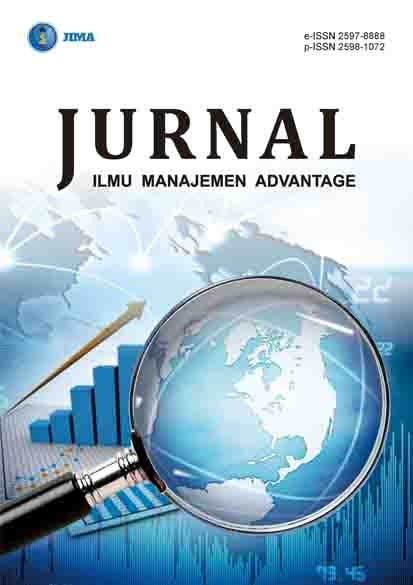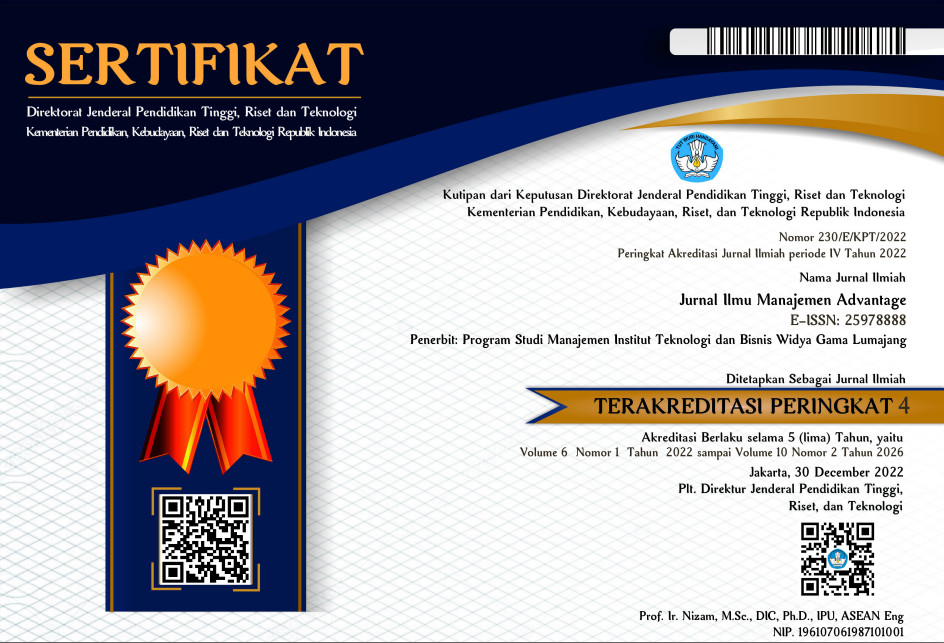Antecedents and Consequences of Visitor Attitude Toward Raja Ali Haji Batam Museum
DOI:
https://doi.org/10.30741/adv.v9i1.1514Keywords:
Educational, Esthetic, Tour Guide Performance, Authenticity, Visitor Attitude, Recommendation IntentionAbstract
Despite the growing need for museums to attract and retain visitors, there's a gap in understanding what truly drives visitor recommendations. This research aimed to investigate the influence of educational, esthetic, tour guide performance, and authenticity on recommendation intention, mediated by visitor attitude, within the context of the Raja Ali Haji Museum in Batam. This study uses cognitive appraisal theory as the underpinning theory. Data were collected from 120 visitors using a cross-sectional research design. Data analysis was conducted using Smart-PLS 3.0, encompassing assessments of outer model measurements, including convergent validity, discriminant validity, and composite reliability. The hypothesis test results indicate that educational, tour guide performance, and authenticity indirectly influence recommendation intention through visitor attitude, while esthetic appeal directly influences recommendation intention. These findings highlight the critical role of visitor attitude as a mediator for several key museum attributes, underscoring the nuanced pathways to fostering visitor recommendations. This research contributes to marketing science by introducing authenticity as an exogenous variable to the existing conceptual model and by adding novel hypotheses regarding visitor attitude influenced by tour guide performance, and recommendation intention influenced by educational, esthetic, tour guide performance, and authenticity.
Downloads
References
Abdillah, & Jogiyanto. (2011). Konsep dan aplikasi PLS (partial least square) untuk penelitian empiris. Badan Penerbit Fakultas Ekonomi Dan Bisnis UGM, Yogyakarta.
Apriliansyah, S. P., & Ernawadi, Y. (2024). Peran kritis tour guide performance dalam meningkatkan revisit intention pengunjung museum geologi. Journal of Economic, Business and Accounting, 7(4). https://doi.org/10.31539/costing.v7i4.8646
Cohen. (1998). A PDP approach to set size effects within the Stroop task: Reply to Kanne, Balota, Spieler, and Faust.
Effendi, S., & Tukiran. (2012). Metode penelitian survei. LP3ES.
Furner, C. P., Drake, J. R., Zinko, R., & Kisling, E. (2022). Online review antecedents of trust, purchase, and recommendation intention: a simulation-based experiment for hotels and AirBnBs. Journal of Internet Commerce, 21(1), 79–103. https://doi.org/10.1080/15332861.2020.1870342
Ghozali, I., & Latan, H. (2015). Partial least squares konsep, metode dan aplikasi menggunakan program WARPPLS 4.0 (2nd ed.). Badan Penerbit Universitas Diponegoro.
Girish, V. G., & Lee, C. K. (2020). Authenticity and its relationship with theory of planned behaviour: case of Camino de Santiago walk in Spain. Current Issues in Tourism, 23(13), 1593–1597. https://doi.org/10.1080/13683500.2019.1676207
Hardisman. (2021). Tanya jawab metodologi penelitian kesehatan / penulis. Gosyen Publishing Sleman.
Hidayatullah, S., Rachmawati, I. K., Aristanto, E., Waris, A., & Patalo, R. G. (2020). Peran sistem informasi pemasaran, kualitas pelayanan dan entrepreneurial marketing serta kepuasan terhadap loyalitas generasi milenial berkunjung ke tempat wisata. Jurnal Ilmiah Bisnis Dan Ekonomi Asia, 14(1), 35–45. https://doi.org/10.32812/jibeka.v14i1.148
Huang, S. (Sam), & van der Veen, R. (2019). The moderation of gender and generation in the effects of perceived destination image on tourist attitude and visit intention: A study of potential Chinese visitors to Australia. Journal of Vacation Marketing, 25(3), 375–389. https://doi.org/10.1177/1356766718814077
Imam Ghozali. (2014). Structural equation modeling metode alternatif dengan partial least squares (PLS) (IV). Badan Penerbit Universitas Diponegoro.
Istiqom, A., Poedjioetami, E., Broto, D., Sulistyo, W., Arsitektur, J., Sipil, T., & Perencanaan, D. (2019). Penerapan tema arsitektur berwawasan lingkungan pada wisata edukasi galeri alam di Prigen Pasuruan, Jawa Timur. 238–242.
Jung, N., Lee, H., Degree, M. S., & Administration, B. (2024). The effects of live commerce’s experience economy factors on consumer’s flow, attitude, and purchase intention. 29(5), 55–66. https://doi.org/10.9708/jksci.2024.29.05.055
Lazarus, R. S. (1991). Emotion and Adaptation. Oxford University Press.
Lee, C. K., Ahmad, M. S., Petrick, J. F., Park, Y. N., Park, E., & Kang, C. W. (2020). The roles of cultural worldview and authenticity in tourists’ decision-making process in a heritage tourism destination using a model of goal-directed behavior. Journal of Destination Marketing and Management, 18(June). https://doi.org/10.1016/j.jdmm.2020.100500
Lee, S., Jeong, E., & Qu, K. (2020). Exploring theme park visitors’ experience on satisfaction and revisit intention: A Utilization of Experience Economy Model. Journal of Quality Assurance in Hospitality and Tourism, 21(4), 474–497. https://doi.org/10.1080/1528008X.2019.1691702
Nugraha, R. N., & Rosa, P. D. (2022). Pengelolaan museum bahari sebagai daya tarik wisata edukasi di Jakarta. Jurnal Inovasi Penelitian, 3(6), 6477–6486. https://stp-mataram.e-journal.id/JIP/article/view/2148
Petty, R. E., Cacioppo, J. T., & Schumann, D. (1983). Central and peripheral routes to advertising effectiveness: the moderating role of involvement. Journal of Consumer Research, 10(2), 135. https://doi.org/10.1086/208954
Skinner, B. F. (1938). The Behavior of organisms.
Smith, & Lazarus, R. S. (1993). Patterns of cognitive appraisal in emotion. Journal of Personality and Social Psychology, 48 (4).
Staddon, J. E. R., & Cerutti, D. T. (2003). Operant Conditioning. Annual Review of Psychology, 54, 115–144. https://doi.org/10.1146/annurev.psych.54.101601.145124
Stepchenkova, S., & Belyaeva, V. (2020). The effect of authenticity orientation on existential authenticity and postvisitation intended behavior. Journal of Travel Research, 60(2), 401–416. https://doi.org/10.1177/0047287519899989
Tan, E., & Rorong, M. J. (2022). Analisa proses komunikasi inovasi QR code sebagai pengembangan objek wisata museum Raja Ali Haji Kota Batam. Scietia journal https://ejournal.upbatam.ac.id/index.php/scientia_journal/article/download/6621/3536
Tanuwijaya, & Susanto. (2024). Pengaruh bauran pemasaran terhadap keputusan berkunjung wisatawan di museum Kebangkitan Nasional. Journal Kanganga, 7(2). https://doi.org/10.31539/kaganga.v7i2.10556
Wardhani, A. K., & Anindyaputri, A. (2020). Sistem informasi pemilihan tempat wisata menggunakan metode weighted product. Indonesian Journal of Technology, Informatics and Science (IJTIS), 2(1), 27–32. https://doi.org/10.24176/ijtis.v2i1.5649
Yamin & Kurniawan. (2011). Partial Least Square Path Modeling. Salemba Apotek.
Downloads
Published
How to Cite
Issue
Section
License
Copyright (c) 2025 Amel Sulawati, Yadi Ernawadi

This work is licensed under a Creative Commons Attribution-NonCommercial 4.0 International License.









